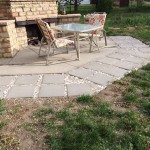How To Build A Patio Floor
Creating a patio floor is a significant undertaking that can dramatically enhance the usability and aesthetic appeal of an outdoor space. It involves careful planning, preparation, and execution to ensure a durable and visually pleasing result. This document outlines the essential steps involved in constructing a patio floor, providing a comprehensive guide for those seeking to undertake this project.
Before commencing the construction of a patio floor, it is imperative to thoroughly assess the existing ground conditions. This includes identifying the soil type, drainage capabilities, and any potential obstacles such as underground utilities or tree roots. Understanding these factors will influence the choice of materials and construction techniques to be employed.
The selection of appropriate materials is a pivotal aspect of patio floor construction. Common choices include concrete pavers, natural stone, brick, and composite decking. Each material possesses distinct characteristics in terms of cost, durability, aesthetic appeal, and ease of installation. Consideration should be given to the intended use of the patio, the overall design scheme of the surrounding landscape, and the long-term maintenance requirements of each material.
Planning and Design
The planning phase is crucial for a successful patio floor installation. This involves determining the size and shape of the patio, taking into account the intended use of the space and the available area. It is also advisable to create a detailed design plan that outlines the layout of the patio, including the placement of any features such as steps, borders, or built-in seating. This design plan should also specify the type of materials to be used and the overall aesthetic of the patio.
Accurate measurement and marking are essential for ensuring a precise and well-proportioned patio. The intended area should be clearly marked using stakes and string, taking into account any existing structures or features that need to be accommodated. It is also important to verify that the marked-out area is level, as this will influence the subsequent excavation and leveling processes.
Obtaining necessary permits is a critical step before commencing any construction project, including patio floor installation. Local building codes and regulations may require permits for certain types of construction, and failure to comply with these requirements can result in fines or project delays. It is advisable to consult with the local building department to determine the specific permit requirements for the project.
The design should account for proper drainage. Standing water on a patio can lead to damage and create a safety hazard. A slight slope, typically about 1/4 inch per foot, should be incorporated into the design to allow water to drain away from the house and other structures. The direction of the slope should be carefully considered to ensure that water is directed away from walkways, doorways, and other areas where it could cause problems.
Site Preparation
Site preparation is a fundamental step in patio floor construction, ensuring a stable and level base for the chosen materials. This process typically involves excavation, compaction, and the installation of a base layer of gravel or crushed stone.
Excavation involves removing the topsoil and any other organic material from the designated patio area. The depth of excavation will depend on the type of materials being used and the desired finished height of the patio. Typically, a depth of at least 6-8 inches is recommended to allow for a sufficient base layer.
Compaction is a critical step in creating a stable base for the patio. After excavation, the exposed soil should be thoroughly compacted using a plate compactor or hand tamper. This will help to prevent settling and ensure that the patio remains level over time. It is also important to compact the base layer of gravel or crushed stone after it has been installed.
Installing a base layer of gravel or crushed stone provides a stable foundation for the patio and helps to facilitate drainage. The base layer should be at least 4 inches thick and should consist of well-graded material that is easy to compact. The gravel or crushed stone should be evenly distributed and compacted to create a smooth and level surface.
Edge restraints are crucial for maintaining the structural integrity and aesthetic appeal of the patio floor. These restraints prevent the paving materials from shifting or spreading over time, ensuring a neat and defined edge to the patio. Edge restraints can be made from a variety of materials, including concrete, wood, or plastic edging specifically designed for this purpose.
When using concrete pavers or natural stone, a bedding layer of sand is often used to provide a smooth and even surface for the pavers to rest on. The sand should be fine and evenly distributed, and it should be compacted using a hand tamper or plate compactor. The thickness of the sand layer should be about 1-2 inches.
Installation Techniques
The installation of the patio floor materials requires precision and attention to detail to ensure a professional and long-lasting result. The specific installation techniques will vary depending on the type of materials being used, but some general principles apply to all types of patio floors.
When installing concrete pavers or natural stone, it is important to lay the pavers in a consistent pattern, ensuring that the joints between the pavers are even and aligned. A rubber mallet can be used to gently tap the pavers into place, ensuring that they are level and firmly seated in the sand layer. Spacers can be used to maintain uniform joint widths.
For brick patios, a variety of patterns can be used, such as running bond, herringbone, or basketweave. The chosen pattern should be carefully planned and executed to create a visually appealing and structurally sound patio. Mortar can be used to secure the bricks in place, or a dry-laid method can be employed, where the bricks are set in a sand base without mortar.
Composite decking offers a low-maintenance alternative to traditional wood decking. The installation of composite decking typically involves attaching the decking boards to a frame of treated lumber using screws or hidden fasteners. The decking boards should be spaced appropriately to allow for expansion and contraction due to temperature changes.
After the patio floor has been installed, the joints between the pavers or bricks should be filled with sand or polymeric sand. Polymeric sand is a special type of sand that contains additives that help to bind the sand particles together, preventing weeds from growing in the joints and stabilizing the patio floor. The sand should be swept into the joints and compacted using a brush or broom.
Once the joints are filled, the patio floor should be thoroughly cleaned to remove any excess sand or debris. A garden hose can be used to rinse the patio, ensuring that the water drains properly. Avoid using harsh chemicals or abrasive cleaners, as these can damage the patio materials.
Sealing the patio floor can help to protect it from stains, water damage, and fading. A variety of sealants are available, depending on the type of materials used. It is important to choose a sealant that is specifically designed for the type of patio floor being sealed and to follow the manufacturer's instructions carefully.
Regular maintenance is essential for keeping the patio floor in good condition. This includes sweeping or blowing the patio regularly to remove leaves, dirt, and debris. Weeds should be removed promptly to prevent them from spreading and damaging the patio. The patio should also be inspected periodically for any signs of damage, such as cracks, chips, or loose pavers. Any necessary repairs should be made promptly to prevent further damage.

How To Build A Backyard Paver Patio All By Yourself Youtube

13 Great Diy Outdoor Patio Flooring Ideas On A Budget The Garden Glove

How To Build A Patio In Weekend Fine Gardening

How To Build A Diy Patio For Under 120 Outdoor Spaces

How To Build A Ground Level Deck

How To Build A Paver Patio Young House Love

How To Build A Platform Deck Diy Family Handyman

13 Great Diy Outdoor Patio Flooring Ideas On A Budget The Garden Glove

How To Build A Ground Level Deck Decks Com

How To Build A Simple Diy Deck On Budget The Home








